Related Research Articles
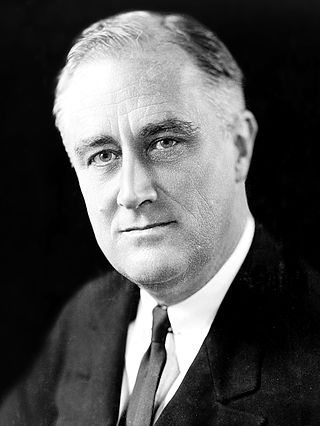
The 1932 United States presidential election was the 37th quadrennial presidential election, held on Tuesday, November 8, 1932. The election took place against the backdrop of the Great Depression. The incumbent Republican President Herbert Hoover was defeated in a landslide by Democrat Franklin D. Roosevelt, the governor of New York and the vice presidential nominee of the 1920 presidential election. Roosevelt was the first Democrat in 80 years to simultaneously win an outright majority of the electoral college and popular vote, a feat last accomplished by Franklin Pierce in 1852, as well as the first Democrat in 56 years to win a majority of the popular vote, which was last done by Samuel J. Tilden in 1876. Roosevelt was the last sitting governor to be elected president until Bill Clinton in 1992. Hoover was the last incumbent to lose an election to another term until Gerald Ford lost 44 years later. The election marked the effective end of the Fourth Party System, which had been dominated by Republicans. It was the first time since 1916 that a Democrat was elected president. Despite disastrous economic conditions due to the Great Depression, Hoover faced little opposition at the 1932 Republican National Convention. Roosevelt was widely considered the front-runner at the start of the 1932 Democratic National Convention, but was not able to clinch the nomination until the fourth ballot of the convention. The Democratic convention chose a leading Southern Democrat, Speaker of the House John Nance Garner of Texas, as the party's vice presidential nominee. Roosevelt united the party, campaigning on the failures of the Hoover administration. He promised recovery with a "New Deal" for the American people.
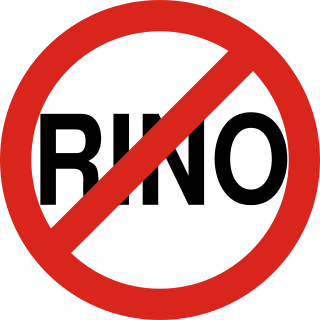
In US politics, Republican In Name Only is a pejorative used to describe politicians of the Republican Party deemed insufficiently loyal to the party, or misaligned with the party's ideology. Similar terms have been used since the early 1900s. The acronym RINO became popular in the 1990s, and both the acronym and the full spelling have become commonly used by former president Donald Trump and his supporters to refer to his critics within the Republican Party.

The 1938 United States Senate elections occurred in the middle of Franklin D. Roosevelt's second term. The 32 seats of Class 3 were contested in regular elections, and special elections were held to fill vacancies. The Republicans gained eight seats from the Democrats, though this occurred after multiple Democratic gains since the 1932 election, leading to the Democrats retaining a commanding lead over the Republicans with more than two-thirds of the legislative chamber.

The 1934 United States Senate elections were held in the middle of Democratic President Franklin D. Roosevelt's first term. The 32 seats of Class 1 were contested in regular elections, and special elections were held to fill vacancies. During the Great Depression, voters strongly backed Roosevelt's New Deal and his allies in the Senate, with Democrats picking up a net of nine seats, giving them a supermajority. This marked the first time that an incumbent president's party gained seats in both houses of Congress in a midterm election, followed by 1998 and 2002. This was also the second time in American history that the opposition party failed to flip any Senate seats, alongside 1914 & 2022.
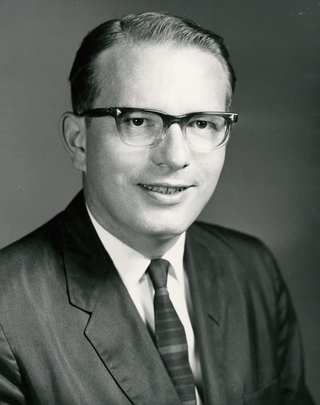
Guy Adrian Vander Jagt was a Republican politician from Michigan. He was a member of the U.S. House of Representatives and Chairman of the National Republican Congressional Committee.

The United States budget comprises the spending and revenues of the U.S. federal government. The budget is the financial representation of the priorities of the government, reflecting historical debates and competing economic philosophies. The government primarily spends on healthcare, retirement, and defense programs. The non-partisan Congressional Budget Office provides extensive analysis of the budget and its economic effects. It has reported that large budget deficits over the next 30 years are projected to drive federal debt held by the public to unprecedented levels—from 98 percent of gross domestic product (GDP) in 2020 to 195 percent by 2050.
Fiscal conservatism or economic conservatism is a political and economic philosophy regarding fiscal policy and fiscal responsibility with an ideological basis in capitalism, individualism, limited government, and laissez-faire economics. Fiscal conservatives advocate tax cuts, reduced government spending, free markets, deregulation, privatization, free trade, and minimal government debt. Fiscal conservatism follows the same philosophical outlook of classical liberalism. This concept is derived from economic liberalism.

The Republican Party, also referred to as the GOP, is one of the two major political parties in the United States. It is the second-oldest extant political party in the United States after its main political rival, the Democratic Party.
In United States politics, modern liberalism is a form of social liberalism. It combines ideas of civil liberty and equality with support for social justice and a well-regulated mixed economy. Modern liberalism opposes corporate monopolies, opposes cuts to the social safety net, and supports a role for government in reducing inequality, increasing diversity, providing access to education, ensuring healthcare, regulating economic activity, and protecting the natural environment. This form of liberalism took shape in the 20th century as the voting franchise and other civil rights were extended to a larger class of citizens, most notably among African Americans and women. Major examples of modern liberal policy programs include the New Deal, the Fair Deal, the New Frontier, the Great Society, and the Affordable Care Act.
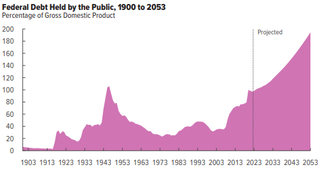
The history of the United States public debt started with federal government debt incurred during the American Revolutionary War by the first U.S treasurer, Michael Hillegas, after the country's formation in 1776. The United States has continuously had a fluctuating public debt since then, except for about a year during 1835–1836. To allow comparisons over the years, public debt is often expressed as a ratio to gross domestic product (GDP). Historically, the United States public debt as a share of GDP has increased during wars and recessions, and subsequently declined.
Liberalism in the United States is based on concepts of unalienable rights of the private individual. The fundamental liberal ideals of:
Like many other U.S. states, the politics of Oregon largely concerns regional issues. Oregon leans Democratic as a state, with both U.S. senators from the Democratic party, as well as four out of Oregon's six U.S. Representatives. The Democratic candidate for president has won in Oregon in every election since 1988. Both houses of Oregon's legislative assembly have been under Democratic control since the 2012 elections.

The New Deal was a series of programs, public work projects, financial reforms, and regulations enacted by President Franklin D. Roosevelt in the United States between 1933 and 1939. Major federal programs and agencies included the Civilian Conservation Corps (CCC), the Works Progress Administration (WPA), the Civil Works Administration (CWA), the Farm Security Administration (FSA), the National Industrial Recovery Act of 1933 (NIRA) and the Social Security Administration (SSA). They provided support for farmers, the unemployed, youth, and the elderly. The New Deal included new constraints and safeguards on the banking industry and efforts to re-inflate the economy after prices had fallen sharply. New Deal programs included both laws passed by Congress as well as presidential executive orders during the first term of the presidency of Franklin D. Roosevelt.

Frank Richardson Kent (1877–1958) was an American journalist and political theorist of the 1920s and 1930s whose Baltimore Sun column "The Great Game of Politics" was syndicated nationally.
The National Commission on Fiscal Responsibility and Reform was a bipartisan Presidential Commission on deficit reduction, created in 2010 by President Barack Obama to identify "policies to improve the fiscal situation in the medium term and to achieve fiscal sustainability over the long run". The 18-member Commission, consisting of 12 members of Congress and six private citizens, first met on April 27, 2010. A report was released on December 1, recommending a combination of spending cuts and tax increases.
Tax expenditures are government revenue losses from tax exclusions, exemptions, deductions, credits, deferrals, and preferential tax rates. They are a counterpart to direct expenditures, in that they both are forms of government spending.
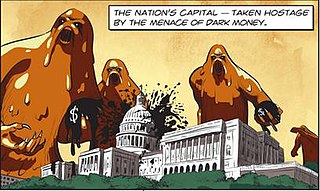
In the politics of the United States, dark money refers to spending to influence elections where the source of the money is not disclosed to voters. In the United States, some types of nonprofit organizations may spend money on campaigns without disclosing who their donors are. The most common type of dark money group is the 501(c)(4). Such organizations can receive unlimited donations from corporations, individuals and unions. Proponents of dark money maintain it is protected under the First Amendment, while critics complain recipients of dark money "knows exactly who he owes a favor", but voters are kept in the dark about connections between donor and politician when favors are paid back.
Progressive conservatism is a political ideology that attempts to combine conservative and progressive policies. While still supportive of capitalist society, it stresses the importance of government intervention in order to improve human and environmental conditions.

The first term of the presidency of Franklin D. Roosevelt began on March 4, 1933, when he was inaugurated as the 32nd president of the United States, and the second term of his presidency ended on January 20, 1941, with his inauguration to a third term. Roosevelt, the Democratic governor of the largest state, New York, took office after defeating incumbent President Herbert Hoover, his Republican opponent in the 1932 presidential election. Roosevelt led the implementation of the New Deal, a series of programs designed to provide relief, recovery, and reform to Americans and the American economy during the Great Depression. He also presided over a realignment that made his New Deal Coalition of labor unions, big city machines, white ethnics, African Americans, and rural white Southerners dominant in national politics until the 1960s and defined modern American liberalism.
Bill Clinton served two tenures as governor of Arkansas. Elected in 1978, Clinton first served as governor for a single term from 1979 until 1981, losing his bid for reelection in 1980. After a two-year interregnum, Clinton returned to the governorship after winning the 1982 election. Clinton would be elected to five further terms, serving until mid-December, 1992, when he resigned amid his transition into the U.S. presidency after having been elected president in the 1992 United States presidential election. Clinton was the second-longest serving governor in the state's history, after Orval Faubus.
References
- 1 2 "tax and spend" . Oxford English Dictionary (Online ed.). Oxford University Press. (Subscription or participating institution membership required.)
- ↑ O'Connor, Elieen; Schiavone, Louise. "Republicans Criticize New Spending In Clinton Budget". cnn.com. CNN. Retrieved 21 November 2020.
- ↑ McLaughlin, Seth. "2020 Democrats embrace 'tax-and-spend liberals' label, expand wish list". The Washington Times. Retrieved 22 November 2020.
- ↑ Sandbu, Martin. "Tax and spend is the new economic orthodoxy". ft.com. Financial Times. Retrieved 21 November 2020.
- 1 2 "United States v. Butler". UNITED STATES v. BUTLER et al. Cornell Law. Retrieved 22 November 2020.
- ↑ Krock, Arthur. "In The Nation: The Ubiquity and Influence of Mr. Hopkins". The New York Times. Retrieved 22 November 2020.
- 1 2 Krock, Arthur. "WIN BACK 10 STATES; Republicans Take Ohio, Wisconsin, Kansas and Massachusetts" . Retrieved 27 July 2018.
- ↑ "Letters to The Times". The New York Times. November 24, 1938, p. 26. Retrieved on May 19, 2009.
- ↑ "Arizona Proposition 208, Tax on Incomes Exceeding $250,000 for Teacher Salaries and Schools Initiative (2020)". Ballotpedia. Retrieved 22 November 2020.
- ↑ "City of San Francisco Housing Bond Issue, Proposition A (November 2015)". Ballotpedia. Retrieved 22 November 2020.
- ↑ Olympia, City of. "Public Safety Levy" . Retrieved 22 November 2020.
- ↑ Vander Jagt, Guy. "Tax-and-Spend Democrats Never Learn". The New York Times. Retrieved 22 November 2020.
- ↑ McLaughlin, Seth. "2020 Democrats embrace 'tax-and-spend liberals' label, expand wish list". The Washington Times. Retrieved 22 November 2020.
- ↑ Elliott, Larry; White, Michael (21 January 1997). "Brown buries the tax and spend image". the Guardian. Retrieved 27 July 2018.
- ↑ "Labour to end tax-and-spend - McDonnell". BBC News. 12 March 2016. Retrieved 27 July 2018.
- ↑ "'Tax and spend' is back". www.uq.edu.au. Retrieved 27 July 2018.